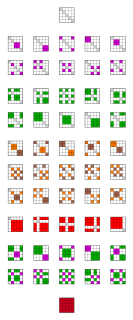In mathematical morphology, a structuring element is a shape, used to probe or interact with a given image, with the purpose of drawing conclusions on how this shape fits or misses the shapes in the image. It is typically used in morphological operations, such as dilation, erosion, opening, and closing, as well as the hit-or-miss transform.

Mathematical morphology (MM) is a theory and technique for the analysis and processing of geometrical structures, based on set theory, lattice theory, topology, and random functions. MM is most commonly applied to digital images, but it can be employed as well on graphs, surface meshes, solids, and many other spatial structures.
Dilation is one of the basic operations in mathematical morphology. Originally developed for binary images, it has been expanded first to grayscale images, and then to complete lattices. The dilation operation usually uses a structuring element for probing and expanding the shapes contained in the input image.

Erosion is one of two fundamental operations in morphological image processing from which all other morphological operations are based. It was originally defined for binary images, later being extended to grayscale images, and subsequently to complete lattices.
Contents
According to Georges Matheron, knowledge about an object (e.g., an image) depends on the manner in which we probe (observe) it. [1] In particular, the choice of a certain structuring element for a particular morphological operation influences the information one can obtain. There are two main characteristics that are directly related to structuring elements:

Georges François Paul Marie Matheron was a French mathematician and geologist, known as the founder of geostatistics and a co-founder of mathematical morphology. In 1968, he created the Centre de Géostatistique et de Morphologie Mathématique at the Paris School of Mines in Fontainebleau. He is known for his contributions on Kriging and mathematical morphology. His seminal work is posted for study and review to the Online Library of the Centre de Géostatistique, Fontainebleau, France.
- Shape. For example, the structuring element can be a "ball" or a line; convex or a ring, etc. By choosing a particular structuring element, one sets a way of differentiating some objects (or parts of objects) from others, according to their shape or spatial orientation.
- Size. For example, one structuring element can be a square or a square. Setting the size of the structuring element is similar to setting the observation scale, and setting the criterion to differentiate image objects or features according to size.











